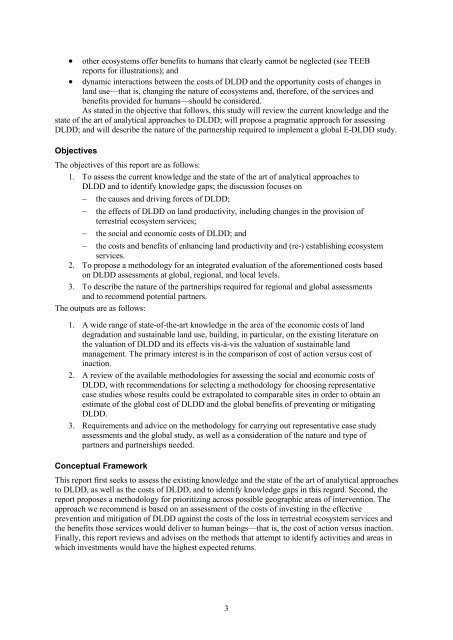The Economics of Desertification, Land Degradation, and Drought
The Economics of Desertification, Land Degradation, and Drought
The Economics of Desertification, Land Degradation, and Drought
You also want an ePaper? Increase the reach of your titles
YUMPU automatically turns print PDFs into web optimized ePapers that Google loves.
• other ecosystems <strong>of</strong>fer benefits to humans that clearly cannot be neglected (see TEEB<br />
reports for illustrations); <strong>and</strong><br />
• dynamic interactions between the costs <strong>of</strong> DLDD <strong>and</strong> the opportunity costs <strong>of</strong> changes in<br />
l<strong>and</strong> use—that is, changing the nature <strong>of</strong> ecosystems <strong>and</strong>, therefore, <strong>of</strong> the services <strong>and</strong><br />
benefits provided for humans—should be considered.<br />
As stated in the objective that follows, this study will review the current knowledge <strong>and</strong> the<br />
state <strong>of</strong> the art <strong>of</strong> analytical approaches to DLDD; will propose a pragmatic approach for assessing<br />
DLDD; <strong>and</strong> will describe the nature <strong>of</strong> the partnership required to implement a global E-DLDD study.<br />
Objectives<br />
<strong>The</strong> objectives <strong>of</strong> this report are as follows:<br />
1. To assess the current knowledge <strong>and</strong> the state <strong>of</strong> the art <strong>of</strong> analytical approaches to<br />
DLDD <strong>and</strong> to identify knowledge gaps; the discussion focuses on<br />
− the causes <strong>and</strong> driving forces <strong>of</strong> DLDD;<br />
− the effects <strong>of</strong> DLDD on l<strong>and</strong> productivity, including changes in the provision <strong>of</strong><br />
terrestrial ecosystem services;<br />
− the social <strong>and</strong> economic costs <strong>of</strong> DLDD; <strong>and</strong><br />
− the costs <strong>and</strong> benefits <strong>of</strong> enhancing l<strong>and</strong> productivity <strong>and</strong> (re-) establishing ecosystem<br />
services.<br />
2. To propose a methodology for an integrated evaluation <strong>of</strong> the aforementioned costs based<br />
on DLDD assessments at global, regional, <strong>and</strong> local levels.<br />
3. To describe the nature <strong>of</strong> the partnerships required for regional <strong>and</strong> global assessments<br />
<strong>and</strong> to recommend potential partners.<br />
<strong>The</strong> outputs are as follows:<br />
1. A wide range <strong>of</strong> state-<strong>of</strong>-the-art knowledge in the area <strong>of</strong> the economic costs <strong>of</strong> l<strong>and</strong><br />
degradation <strong>and</strong> sustainable l<strong>and</strong> use, building, in particular, on the existing literature on<br />
the valuation <strong>of</strong> DLDD <strong>and</strong> its effects vis-à-vis the valuation <strong>of</strong> sustainable l<strong>and</strong><br />
management. <strong>The</strong> primary interest is in the comparison <strong>of</strong> cost <strong>of</strong> action versus cost <strong>of</strong><br />
inaction.<br />
2. A review <strong>of</strong> the available methodologies for assessing the social <strong>and</strong> economic costs <strong>of</strong><br />
DLDD, with recommendations for selecting a methodology for choosing representative<br />
case studies whose results could be extrapolated to comparable sites in order to obtain an<br />
estimate <strong>of</strong> the global cost <strong>of</strong> DLDD <strong>and</strong> the global benefits <strong>of</strong> preventing or mitigating<br />
DLDD.<br />
3. Requirements <strong>and</strong> advice on the methodology for carrying out representative case study<br />
assessments <strong>and</strong> the global study, as well as a consideration <strong>of</strong> the nature <strong>and</strong> type <strong>of</strong><br />
partners <strong>and</strong> partnerships needed.<br />
Conceptual Framework<br />
This report first seeks to assess the existing knowledge <strong>and</strong> the state <strong>of</strong> the art <strong>of</strong> analytical approaches<br />
to DLDD, as well as the costs <strong>of</strong> DLDD, <strong>and</strong> to identify knowledge gaps in this regard. Second, the<br />
report proposes a methodology for prioritizing across possible geographic areas <strong>of</strong> intervention. <strong>The</strong><br />
approach we recommend is based on an assessment <strong>of</strong> the costs <strong>of</strong> investing in the effective<br />
prevention <strong>and</strong> mitigation <strong>of</strong> DLDD against the costs <strong>of</strong> the loss in terrestrial ecosystem services <strong>and</strong><br />
the benefits those services would deliver to human beings—that is, the cost <strong>of</strong> action versus inaction.<br />
Finally, this report reviews <strong>and</strong> advises on the methods that attempt to identify activities <strong>and</strong> areas in<br />
which investments would have the highest expected returns.<br />
3

















